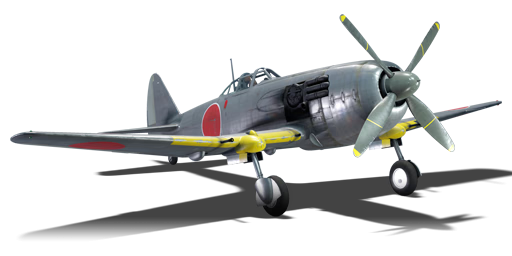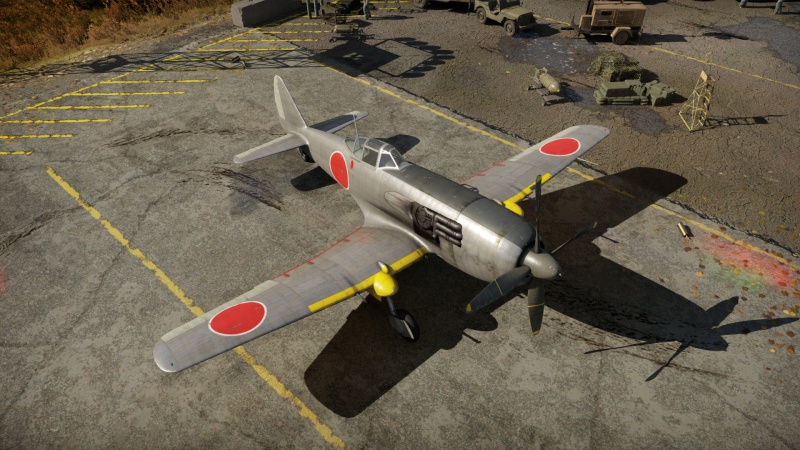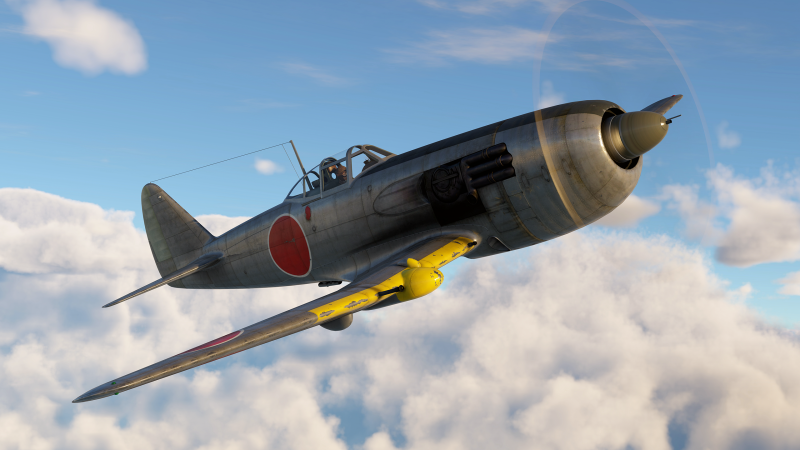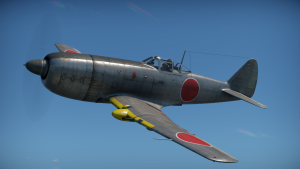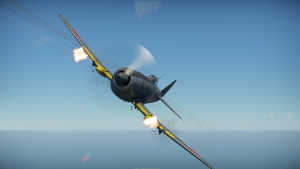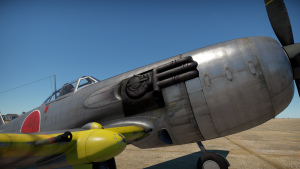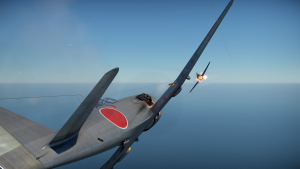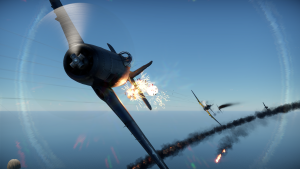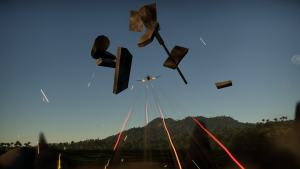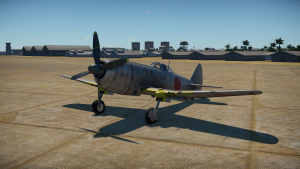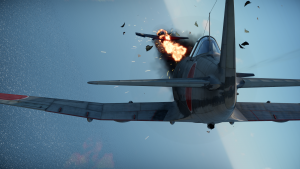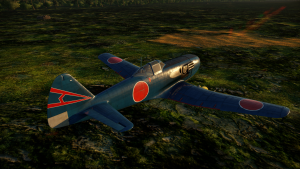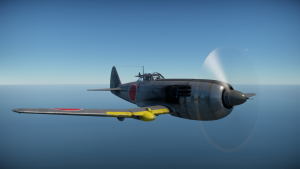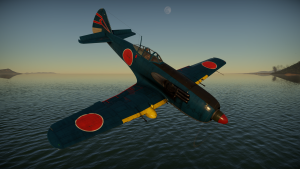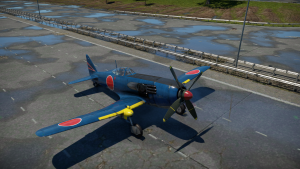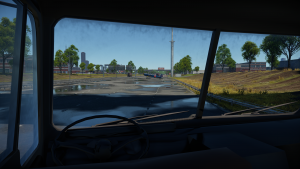Difference between revisions of "Ki-87"
m (→Manual Engine Control: Some changes/updates to what i wrote before) (Tag: Visual edit) |
Colok76286 (talk | contribs) (Edits) |
||
| Line 157: | Line 157: | ||
After you reach desired altitude, and you are about to dive on someone or level out (15-10 degrees), change propeller pitch to 75% and radiator to 10% or lower, if you want to conserve as much energy as possible. | After you reach desired altitude, and you are about to dive on someone or level out (15-10 degrees), change propeller pitch to 75% and radiator to 10% or lower, if you want to conserve as much energy as possible. | ||
| − | Change prop pitch back to 100% if you end up in vertical | + | Change prop pitch back to 100% if you end up in vertical or stall fight (but only after you become slower than 350 km/h) |
=== Pros and cons === | === Pros and cons === | ||
| Line 189: | Line 189: | ||
== History == | == History == | ||
<!-- ''Describe the history of the creation and combat usage of the aircraft in more detail than in the introduction. If the historical reference turns out to be too long, take it to a separate article, taking a link to the article about the vehicle and adding a block "/History" (example: <nowiki>https://wiki.warthunder.com/(Vehicle-name)/History</nowiki>) and add a link to it here using the <code>main</code> template. Be sure to reference text and sources by using <code><nowiki><ref></ref></nowiki></code>, as well as adding them at the end of the article with <code><nowiki><references /></nowiki></code>. This section may also include the vehicle's dev blog entry (if applicable) and the in-game encyclopedia description (under <code><nowiki>=== In-game description ===</nowiki></code>, also if applicable).'' --> | <!-- ''Describe the history of the creation and combat usage of the aircraft in more detail than in the introduction. If the historical reference turns out to be too long, take it to a separate article, taking a link to the article about the vehicle and adding a block "/History" (example: <nowiki>https://wiki.warthunder.com/(Vehicle-name)/History</nowiki>) and add a link to it here using the <code>main</code> template. Be sure to reference text and sources by using <code><nowiki><ref></ref></nowiki></code>, as well as adding them at the end of the article with <code><nowiki><references /></nowiki></code>. This section may also include the vehicle's dev blog entry (if applicable) and the in-game encyclopedia description (under <code><nowiki>=== In-game description ===</nowiki></code>, also if applicable).'' --> | ||
| − | Improved metallurgy and engineering in the 1930s saw a massive leap in aircraft performance, especially the once bulky, boxy, lumbering bombers reborn as sleek and sexy machines that left old fashioned wooden fighters in its vapour trail. | + | Improved metallurgy and engineering in the 1930s saw a massive leap in aircraft performance, especially the once bulky, boxy, lumbering bombers reborn as sleek and sexy machines that left old fashioned wooden fighters in its vapour trail. It was not long before those flying rag fighters were also updated with gleaming aluminum and once again surpassed the bombers top speed. Yet bombers still had a trick up their sleeves, altitude. |
[[File:Ki87 port.png|thumb|Ki-87 at the cargo port]] | [[File:Ki87 port.png|thumb|Ki-87 at the cargo port]] | ||
| − | Flying above 9,000 m (29,500 ft) in super cold thin air and rarefied oxygen was both a technical and physiological challenge. | + | Flying above 9,000 m (29,500 ft) in super cold thin air and rarefied oxygen was both a technical and physiological challenge. The long wings and large interiors of bombers offered space needed for extreme high altitude flight, example the Ju 86P/R bomber which flew above 12,000 m (40,000 ft) with impunity over England, beyond the RAFs reach for months. The B-17 and B-24 could also operate at altitudes the Bf 109 and Fw 190 had difficulty reaching. |
[[File:Ki87 fromtruck.png|thumb|The Ki-87 from another angle in Cargo Port]] | [[File:Ki87 fromtruck.png|thumb|The Ki-87 from another angle in Cargo Port]] | ||
| − | Predicting the same for Japan, the military wisely ordered research into high altitude single engine fighters as early as 1942 and by 1943 work was underway on the future Nakajima Ki-87 and the alternate Tachikawa Ki-94. | + | Predicting the same for Japan, the military wisely ordered research into high altitude single engine fighters as early as 1942 and by 1943 work was underway on the future Nakajima Ki-87 and the alternate Tachikawa Ki-94. At 12,000 m the air density is about 1/4 that of sea level necessitating a huge supercharged engine, but its internal "blower" needed an additional boost so a "turbo-supercharger" was added, powered by high velocity exhaust gas. This combination is exactly like the P-47 Thunderbolt has, except this time the turbo was mounted on the right side of nose on the prototypes and not in rear fuselage. High aspect-ratio wings were chosen for the thin air (compare Fw 190 with Ta 152), but with limited space to mount the dual pair of 30 mm and 20 mm cannons in an unusual step Nakajima chose a landing gear retraction like on P-40 Kittyhawk. High altitude flight is also extremely uncomfortable for the pilot so the cockpit was partially pressurized and extra tanks of oxygen installed. Pilot armour, thick bulletproof glass, self-sealing fuel tanks, and hard point for bombs were also added. Finally enough fuel for at least 2 hours flight resulted in a massive aircraft for the Japanese, well over twice the weight of the A6M2 Zero. |
| − | It was an enormous technical challenge for Japanese industry taking a long time to overcome teething issues. | + | It was an enormous technical challenge for Japanese industry taking a long time to overcome teething issues. Japanese aircraft rarely utilized turbo-superchargers in their planes, so experience in operation was limited, and although the 90° retracting gear was a favourite design, it took Nakajima months to get it to operate correctly. |
| − | The prototype flew for the first time in April 1945 at a time when the anticipated B-29 bomber was pounding Japan, but by then it was too late. | + | The prototype flew for the first time in April 1945 at a time when the anticipated B-29 bomber was pounding Japan, but by then it was too late. Disruption by bombing and dwindling resources prevented the second prototype from flying and attrition of what little fighter defence Japan had. Ironically, with such weak home defence, the B-29s flew much lower so they could bomb more accurately, negating the purpose of the high altitude Ki-87. |
== Media == | == Media == | ||
| Line 207: | Line 207: | ||
;Videos | ;Videos | ||
| − | {{Youtube-gallery|4vA1mwpSG2Q|'''{{PAGENAME}} - Mr Spark Ruins The Bomber Hunting Party''' - ''Napalmratte''|xklKT8qdvPo|'''The Shooting Range #20''' - ''Metal Beasts'' section at 00:42 discusses the Ki-87.|eaefVIIZo78|'''Premium Review: {{PAGENAME}} [Headon Monster]''' | + | {{Youtube-gallery|4vA1mwpSG2Q|'''{{PAGENAME}} - Mr Spark Ruins The Bomber Hunting Party''' - ''Napalmratte''|xklKT8qdvPo|'''The Shooting Range #20''' - ''Metal Beasts'' section at 00:42 discusses the Ki-87.|eaefVIIZo78|'''Premium Review: {{PAGENAME}} [Headon Monster]''' - ''Jengar''|khGg-GvfWLo|'''Japanese Thunderbolt - {{PAGENAME}} Review - 1.63''' - ''MikeGoesBoom''}} |
== See also == | == See also == | ||
Revision as of 22:01, 4 December 2022
Contents
Description
The Ki-87 is a premium rank IV Japanese fighter
with a battle rating of 6.0 (AB/SB) and 5.7 (RB). It was introduced in Update 1.63 "Desert Hunters". Originally a pack vehicle, it was discontinued from the store after the 2018 Independence Day Sale, but was brought back for War Thunder's 7th Anniversary as a premium purchasable in-game for 6,090 Golden Eagles ![]() .
.
The Ki-87 feels similar to a Japanese P-47. It has poor energy retention in very sharp turns, a lacklustre roll rate, and a sluggish feel. The Ki-87 has issues with overheating on WEP, and you'll need to use manual engine control to operate this plane at its best. However, all these flaws mean nothing to an experienced pilot, as the Ki-87 has the most fearsome armament of the super props. The cannons have excellent velocity, and usually one shot everything, and bombers fear you like the plague. The Ki-87 can reach amazing speeds in dives, and you can use tactics to force head-ons with many opponents.
The Ki-87 makes use of a turbo-supercharger, meaning that it won't suffocate as much at high altitudes, so you can keep your engagements high. Planes like the Yak-3, F4U Corsair, and Bf 109 will be outclassed by the Ki-87 because of their poor high altitude performance. It is important to note that the turbo supercharger is not controlled by manual engine controls, so you won't need to worry about adjusting your supercharger gear or turbocharger settings.
Using WEP, the Ki-87 is able to climb to just over 5,500 m in five minutes, a strong climb rate. Bombers spawn in at 3,000 m so you can quickly climb above for positional advantage for booming and zooming. If the Ki-87 retains momentum from the dive and engages the targets, it will be able to climb back up to the operational altitude it was before engaging the enemy. It is recommended to take the minimum load of fuel, set your guns targeting to 500 m and turn on vertical targeting. You should run the tracer belts for your 30 mm cannons and the universal belt for your 20 mm cannons.
For landings, slow to at least 300 km/h (180 mph) before dropping the main gear and 250 km/h for flaps. Ideally, be about 50 m in altitude at the end of the runway and hold 200 km/h until touchdown.
General info
Flight performance
The flight performance feels slow and sluggish, yet powerful. The turning and energy retention is not good either. This plane also has overheating issues. to solve performance issues, it's always best to go for a side climb, especially when in uptiers! The plane dives insanely well. The turbo supercharger will keep the plane's performance up while at altitudes above 5,000 metres.
| Characteristics | Max Speed (km/h at 10,000 m) |
Max altitude (metres) |
Turn time (seconds) |
Rate of climb (metres/second) |
Take-off run (metres) | |||
|---|---|---|---|---|---|---|---|---|
| AB | RB | AB | RB | AB | RB | |||
| Stock | 684 | 664 | 13800 | 23.1 | 23.9 | 11.6 | 11.6 | 370 |
| Upgraded | 739 | 707 | 21.6 | 22.0 | 23.0 | 15.0 | ||
Details
| Features | ||||
|---|---|---|---|---|
| Combat flaps | Take-off flaps | Landing flaps | Air brakes | Arrestor gear |
| ✓ | ✓ | ✓ | X | X |
| Limits | ||||||
|---|---|---|---|---|---|---|
| Wings (km/h) | Gear (km/h) | Flaps (km/h) | Max Static G | |||
| Combat | Take-off | Landing | + | - | ||
| 880 | 320 | 457 | 428 | 280 | ~13 | ~6 |
| Optimal velocities (km/h) | |||
|---|---|---|---|
| Ailerons | Rudder | Elevators | Radiator |
| < 450 | < 450 | < 460 | > 324 |
Survivability and armour
- 70 mm Bulletproof glass in cockpit front.
- 16 mm Steel plate behind the pilot.
Modifications and economy
Armaments
Offensive armament
The Ki-87 is armed with:
- 2 x 30 mm Ho-155 cannons, wing-mounted (150 rpg = 300 total)
- 2 x 20 mm Ho-5 cannons, wing-mounted (150 rpg = 300 total)
Japanese rank IV aircraft are typically armed with a respectable array of guns, and the Ki-87 is no exception. Although the 20 mm Ho-5s are nothing to write home about, the 30 mm cannons are some of the most feared, respected and deadly weapons in the entire game. When armed with the Tracer belt, the Japanese 30 mm cannons have a muzzle velocity that surpasses even the M2 and M3 Browning .50 cal HMGs at a staggering 920 m/s, and when combined with the high explosive filler and large calibre, these beasts will make short work of any aircraft that's unfortunate enough to end up in their crosshairs.
The usual issue with 30 mm cannons on WW2-era propeller planes - that being their lack of sufficient ammunition capacity - is notably absent on the Ki-87, which mounts 150 round per gun instead of the usual 60 seen on other aircraft like the Ki-84 hei and J7W1. Although this increased ammunition capacity is indeed wonderful, the pilot should still take care to not be too trigger happy, as the exceptional ballistics of the cannons will prevent the need to waste copious amounts of bullets on a single target, increasing the endurance of the aircraft in the hands of a patient pilot.
Suspended armament
The Ki-87 can be outfitted with the following ordnance:
- Without load
- 1 x 50 kg Army Type 94 GPHE bomb (50 kg total)
- 1 x 250 kg Army Type 92 GPHE bomb (250 kg total)
Usage in battles
Unlike the usual Japanese low-altitude and highly manoeuvrable fighter aircraft, the Ki-87 is a high-altitude bomber interceptor with mediocre speed and climb rate but less impressive agility. Featuring something relatively new for a Japanese fighter, the Ki-87 has a notably visible turbo-supercharger to boost its high altitude performance at the cost of aircraft weight and size. As such, it cannot be played like most other aircraft from the Japanese tree, but rather as a reserved Boom-&-Zoom that can abuse its brutal acceleration in a dive to pick off unwary victims.
For engaging the enemy, The Ki-87 is best at boom-and-zoom tactics. Sideclimb to around 6,000 m and fly over enemy formations, once in position roll the plane to target, maintain coordinated control and correct rudder as at that altitude it is very easy to stall. Descend fast but not so much that the controls get sluggish. Once lined up and in range fire a short burst, the very heavy armament will rip the enemy plane apart; even evasive countermeasures will be insufficient for a properly executed Boom & Zoom.
If no bombers are present, then you might have issues engaging enemy fighters. The Ki-87 can only do a 21 m/s climb at 17 degrees, which makes it vulnerable to being outclimbed by nearly everything. As such, you'll need to side climb and then engage from the side. Do not try to turn with anything.
Against heavily armed aircraft such as the B-17, B-24, and B-29, and other heavy bombers, climb at least 600 m above them use slashing boom and zoom tactic firing short bursts, once the bullets hit the target, fire longer busts then jump back up. Ideally you should aim for large critical parts such as the wings and tail plane. The cannons on the Ki-87 will make short work of essential components and being substantial offer best chance of hitting. Never attack behind and at nearly same speed as you become a perfect target for multiple weapons. The Ki-87's fuel tanks are somewhat easy to ignite, and you won't last long if they do.
Tactics to Win With
- Force head-ons: The Ki-87 can't energy fight or turn fight with any props (save Ta 152 C-3 and P-47M-1-RE). It will be outclassed. The only time you should ever turn fight is if the enemy is crippled or in a low energy state. To deal with fighters that are higher than you, you need to step up and force a head-on. Most likely, Allied players will take the head-on. Your guns' good velocity should be enough to kill them. Remember to pull off early, as even a quick burst can kill you. If the enemy is higher than you and appears to engage, dive down. The enemy will most likely level out. Keep your speed high, as this will allow you to pull up and engage in vertical head-ons. This is your last chance to score the kill, as the enemy will now be at an advantage.
- Keep your speed high: You need to worry about speed and altitude. DO NOT go for ground targets, as you will be an easy target for enemy fighters (a low and slow Ki-87 is as good as dead). Instead, keep your speed and altitude high, and have spatial awareness. Know where your enemy is.
Manual Engine Control
| MEC elements | ||||||
|---|---|---|---|---|---|---|
| Mixer | Pitch | Radiator | Supercharger | Turbocharger | ||
| Oil | Water | Type | ||||
| Controllable | Controllable Not auto controlled |
Controllable Not auto controlled |
Controllable Not auto controlled |
Separate | Not controllable 1 gear |
Auto controlled |
You'll need to keep the prop pitch at 98-99% while in steeper climb, and adjust it to 75% when traveling above 700 km/h. The radiators should be kept at 100% (if prop pitch 90% or above) while on WEP.
After you reach desired altitude, and you are about to dive on someone or level out (15-10 degrees), change propeller pitch to 75% and radiator to 10% or lower, if you want to conserve as much energy as possible.
Change prop pitch back to 100% if you end up in vertical or stall fight (but only after you become slower than 350 km/h)
Pros and cons
Pros:
- Excels in high-altitude bomber intercepting
- Great gun velocity, you can engage bombers from over 1 km away
- Powerful armament consisting of 2 x 30 mm cannons and 2 x 20 mm cannons
- No wing-mounted fuel tanks
- 30 mm cannons have a huge amount of ammo
- High red-line speed of 840 km/h
- Fast at diving
- Can equip bombs, although it will affect the aircraft's speed and turning time
Cons:
- Not as manoeuvrable as other Japanese aircraft, feels very sluggish
- Really bad energy retention, especially when coming out of a dive
- Fuselage fuel-tank is susceptible to fire
- Overheats extremely quickly, it's advisable to open the radiators using Manual Engine Controls
- Mediocre climb rate
- No interceptor spawn
- 30 mm HEF-T has only a maximum penetration of 2 mm
- Begins to lock up at around 700 km/h (435 mph)
History
Improved metallurgy and engineering in the 1930s saw a massive leap in aircraft performance, especially the once bulky, boxy, lumbering bombers reborn as sleek and sexy machines that left old fashioned wooden fighters in its vapour trail. It was not long before those flying rag fighters were also updated with gleaming aluminum and once again surpassed the bombers top speed. Yet bombers still had a trick up their sleeves, altitude.
Flying above 9,000 m (29,500 ft) in super cold thin air and rarefied oxygen was both a technical and physiological challenge. The long wings and large interiors of bombers offered space needed for extreme high altitude flight, example the Ju 86P/R bomber which flew above 12,000 m (40,000 ft) with impunity over England, beyond the RAFs reach for months. The B-17 and B-24 could also operate at altitudes the Bf 109 and Fw 190 had difficulty reaching.
Predicting the same for Japan, the military wisely ordered research into high altitude single engine fighters as early as 1942 and by 1943 work was underway on the future Nakajima Ki-87 and the alternate Tachikawa Ki-94. At 12,000 m the air density is about 1/4 that of sea level necessitating a huge supercharged engine, but its internal "blower" needed an additional boost so a "turbo-supercharger" was added, powered by high velocity exhaust gas. This combination is exactly like the P-47 Thunderbolt has, except this time the turbo was mounted on the right side of nose on the prototypes and not in rear fuselage. High aspect-ratio wings were chosen for the thin air (compare Fw 190 with Ta 152), but with limited space to mount the dual pair of 30 mm and 20 mm cannons in an unusual step Nakajima chose a landing gear retraction like on P-40 Kittyhawk. High altitude flight is also extremely uncomfortable for the pilot so the cockpit was partially pressurized and extra tanks of oxygen installed. Pilot armour, thick bulletproof glass, self-sealing fuel tanks, and hard point for bombs were also added. Finally enough fuel for at least 2 hours flight resulted in a massive aircraft for the Japanese, well over twice the weight of the A6M2 Zero.
It was an enormous technical challenge for Japanese industry taking a long time to overcome teething issues. Japanese aircraft rarely utilized turbo-superchargers in their planes, so experience in operation was limited, and although the 90° retracting gear was a favourite design, it took Nakajima months to get it to operate correctly.
The prototype flew for the first time in April 1945 at a time when the anticipated B-29 bomber was pounding Japan, but by then it was too late. Disruption by bombing and dwindling resources prevented the second prototype from flying and attrition of what little fighter defence Japan had. Ironically, with such weak home defence, the B-29s flew much lower so they could bomb more accurately, negating the purpose of the high altitude Ki-87.
Media
- Skins
- Videos
See also
- Japanese late-war Pacific fighters
External links
| Nakajima Aircraft Company (中島飛行機株式会社 ) | |
|---|---|
| Fighters | Ki-27 otsu · Ki-27 otsu Tachiarai |
| Ki-43-I · Ki-43-II · Ki-43-III otsu | |
| Ki-44-I · Ki-44-I 34 · Ki-44-II otsu · Ki-44-II hei | |
| Ki-84 ko · Ki-84 otsu · Ki-84 hei | |
| Ki-87 | |
| Hydroplanes | A6M2-N* |
| Interceptors | J1N1 · J5N1 |
| Bombers | B5N2 |
| B6N1 Model 11 · B6N2 Model 12 · B6N2a Model 12Ko | |
| G5N1 · G8N1 | |
| Ki-49-I · Ki-49-IIa · Ki-49-IIb · Ki-49-IIb/L | |
| Recon | E8N2 |
| Jet Fighters | Kikka |
| Captured | ␗Ki-27 otsu · ▃Ki-43-II · ␗Ki-43-III ko · ␗Ki-44-II hei · ␗Ki-84 ko |
| *Refit of the Mitsubishi A6M2 mod. 11 | |
| See also | Fuji Heavy Industries (1957-2017) |
| Japan fighters | |
|---|---|
| Navy | |
| Carrier-based fighter | |
| A5M | A5M4 · Hagiri's A5M4 |
| A6M | A6M2 mod. 11 · A6M2 · A6M3 · A6M3 mod. 22 · A6M3 mod. 22Ko · A6M5 · A6M5 Ko · A6M5 otsu · A6M5 Hei · A6M6c |
| A7He | A7He1* |
| A7M | A7M1 (NK9H) · A7M2 |
| Land-based Fighter | |
| J2M | J2M2 · J2M3 · J2M4 Kai · J2M5 · J2M5 (30 mm) |
| J6K | J6K1 |
| J7W | J7W1 |
| N1K-J | N1K1-Ja · N1K2-J · N1K2-Ja |
| Fighter seaplane | |
| N1K | N1K1 |
| A6M-N | A6M2-N |
| Army | |
| Ki-10 | Ki-10-I · Ki-10-I C · Ki-10-II · Ki-10-II C |
| Ki-27 | Ki-27 otsu · Ki-27 otsu Tachiarai |
| Ki-43 | Ki-43-I · Ki-43-II · Ki-43-III otsu |
| Ki-44 | Ki-44-I · Ki-44-I 34 · Ki-44-II otsu · Ki-44-II hei |
| Ki-61 | Ki-61-I ko · Ki-61-I otsu · Ki-61-I hei · Tada's Ki-61-I hei · Ki-61-I tei · Ki-61-II Otsu Kai |
| Ki-84 | Ki-84 ko · Ki-84 otsu · Ki-84 hei |
| Ki-87 | Ki-87 |
| Ki-94 | Ki-94-II |
| Ki-100 | Ki-100 · Ki-100-II |
| Other countries | ▅F4U-1A · ▅P-51C-11-NT · ▅Bf 109 E-7 · ▅Fw 190 A-5 |
| *Imported designation of the He 112 (A6M was in development - A7M would take A7 designation after the cancelation of the A7He) | |
| Japan premium aircraft | |
|---|---|
| Fighters | Hagiri's A5M4 · A7He1 · Ki-27 otsu Tachiarai |
| Ki-44-II otsu · ▅Bf 109 E-7 · ▅F4U-1A · Ki-100-II · Ki-44-I 34 | |
| ▅Fw 190 A-5 · A7M1 (NK9H) · Tada's Ki-61-I hei · ▅P-51C-11-NT | |
| J2M4 Kai · A6M5 Ko · A6M6c · J2M5 · Ki-87 · J6K1 | |
| Twin-engine fighters | Ki-96 |
| Jet fighters | F-86F-40 JASDF▅ · T-2 Early · F-4EJ ADTW |
| Strike aircraft | ▄AV-8S |
| Bombers | Ki-21-I hei · Ki-48-II otsu · H8K3 · B7A2 (Homare 23) · ▅B-17E |


